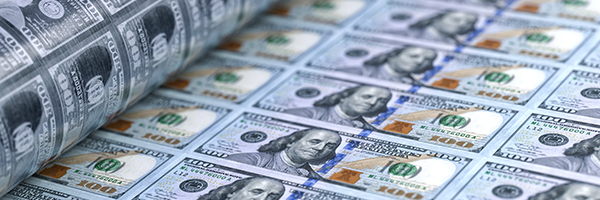 May 17, 2024
May 17, 2024
What You Need to Know Today:
CPI inflation hits the mark for April: Is this the start of another drop in inflation, finally
Today, May 15, the April Consumer Price Index report dangled new hope in front of investors. The all-items index annual rate of inflation dropped to an annual 3.4% rate from 3.5% in March. The core index, which leaves out food and energy prices, fell to an annual rate of 3.6%, down from 3.8% in March. Those annual rates are still way above the Federal Reserve’s inflation target of 2%. But after three straight reports where the inflation rate came in above market expectations todays report, which hit projections right on the mark, came as good news. In recent weeks Wall Street has speculated that inflation is set to resume its downward course starting with the April report. And after stalling above 3.5%, annual inflation would resume its downward path.

Please Watch My New YouTube video: Hot Button Moves NOW: Buy Equal Weight S&P 500 Index ETFs
Today’s Hot Button Moves NOW video is Buy Equal Weight S&P Indexes. If you’re concerned about volatility in the tech sector but want to stay in the market, equal weight S&P indexes may be a good alternative. Stocks like Nvidia with a market cap of around 2 trillion, have a lot more weight in the common version of the market cap weighted S&P 500 index than a stock with a smaller cap. In the last week or so, we’ve seen equal weight indexes converge with the longer-term out-performance of the weighted indexes. Using an equal weight index lowers your exposure to the big, now more volatile stocks while keeping you in the market. The Invesco S&P 500 Equal Weight ETF (RSP) is a low expense ratio ETF (.2%) with about $55 billion in assets under management. Year to date, RSP is up 4.68% versus 9.9% year to date for the market cap weighted ETF from Vanguard (VOO). However, for the last 3 months you see a 4.3% return for the equal weight index versus a 4.19% for the market cap weighted index. In the last week, for the first time in a long time, the equal weight index outperformed the weighted index. While one week isn’t a trend, it does seem like the returns are converged. Shifting some S&P exposure from the large cap stocks to this equal weight ETF is a good choice to stay in the game with less volatility. I’m going to make this shift in my Perfect 5 ETF Portfolio on my subscription JubakAM.com site tomorrow May 16.

CPI inflation hits the mark for April: Is this the start of another drop in inflation, finally
Today, May 15, the April Consumer Price Index report dangled new hope in front of investors. The all-items index annual rate of inflation dropped to an annual 3.4% rate from 3.5% in March. The core index, which leaves out food and energy prices, fell to an annual rate of 3.6%, down from 3.8% in March. Those annual rates are still way above the Federal Reserve’s inflation target of 2%. But after three straight reports where the inflation rate came in above market expectations todays report, which hit projections right on the mark, came as good news. In recent weeks Wall Street has speculated that inflation is set to resume its downward course starting with the April report. And after stalling above 3.5%, annual inflation would resume its downward path.

Powell says Slow–as market waits for Wednesday CPI inflation report
Granted that the remarks weren’t delivered at the most high profile venue–a panel discussion at the Foreign Bankers Association meeting in Amsterdam–but I read Federal Reserve chairmen Jerome Powell as saying that the U.S.central bank might hold interest rates steady for longer than now expected by WallStreet. Ahead of new inflation data from the Consumer Price Index for April due tomorrow, anyway. On the day before the meeting economists were expecting the annual inflation rate at both the all-time and core levels to have dropped by 10 or 20 basis in April

Special Report: The 5 Next Big Things–Intro to my method and the first Next Big Thing, AI Phase 2
This special report is about the history of the future. And how to score big returns by investing in the future. By studying the past histories of the future, we can understand what kind of bets on the future pay off with outsized gains. Think about it this way.

Saturday Night Quarterback (on a Sunday) says, For the week ahead expect…
I expect more inflation news. What else? On Wednesday, May 15, the Bureau of Labor Statistics will release its report on Consumer Price Index (CPI) inflation for April. Even though the CPI isn’t the Federal Reserve’s preferred inflation measure (that’s the Person Consumption Expenditures (PCE) index, which won’t be released (for April) until May 31), Wall Street is looking for a trend in the CPI report that will point to the inflation rate moving lower convincingly enough so that the U.S. central bank can begin to cut interest rates at its September meeting.

Special Report: The 5 Next Big Things–Intro to my method and the first Next Big Thing, AI Phase 2
This special report is about the history of the future. And how to score big returns by investing in the future. By studying the past histories of the future, we can understand what kind of bets on the future pay off with outsized gains. Think about it this way.
Live Market Report (20 minute delay)

Please Watch My New YouTube video: Hot Button Moves NOW: Buy Equal Weight S&P 500 Index ETFs
Today’s Hot Button Moves NOW video is Buy Equal Weight S&P Indexes. If you’re concerned about volatility in the tech sector but want to stay in the market, equal weight S&P indexes may be a good alternative. Stocks like Nvidia with a market cap of around 2 trillion, have a lot more weight in the common version of the market cap weighted S&P 500 index than a stock with a smaller cap. In the last week or so, we’ve seen equal weight indexes converge with the longer-term out-performance of the weighted indexes. Using an equal weight index lowers your exposure to the big, now more volatile stocks while keeping you in the market. The Invesco S&P 500 Equal Weight ETF (RSP) is a low expense ratio ETF (.2%) with about $55 billion in assets under management. Year to date, RSP is up 4.68% versus 9.9% year to date for the market cap weighted ETF from Vanguard (VOO). However, for the last 3 months you see a 4.3% return for the equal weight index versus a 4.19% for the market cap weighted index. In the last week, for the first time in a long time, the equal weight index outperformed the weighted index. While one week isn’t a trend, it does seem like the returns are converged. Shifting some S&P exposure from the large cap stocks to this equal weight ETF is a good choice to stay in the game with less volatility. I’m going to make this shift in my Perfect 5 ETF Portfolio on my subscription JubakAM.com site tomorrow May 16.

CPI inflation hits the mark for April: Is this the start of another drop in inflation, finally
Today, May 15, the April Consumer Price Index report dangled new hope in front of investors. The all-items index annual rate of inflation dropped to an annual 3.4% rate from 3.5% in March. The core index, which leaves out food and energy prices, fell to an annual rate of 3.6%, down from 3.8% in March. Those annual rates are still way above the Federal Reserve’s inflation target of 2%. But after three straight reports where the inflation rate came in above market expectations todays report, which hit projections right on the mark, came as good news. In recent weeks Wall Street has speculated that inflation is set to resume its downward course starting with the April report. And after stalling above 3.5%, annual inflation would resume its downward path.

Powell says Slow–as market waits for Wednesday CPI inflation report
Granted that the remarks weren’t delivered at the most high profile venue–a panel discussion at the Foreign Bankers Association meeting in Amsterdam–but I read Federal Reserve chairmen Jerome Powell as saying that the U.S.central bank might hold interest rates steady for longer than now expected by WallStreet. Ahead of new inflation data from the Consumer Price Index for April due tomorrow, anyway. On the day before the meeting economists were expecting the annual inflation rate at both the all-time and core levels to have dropped by 10 or 20 basis in April

Special Report: The 5 Next Big Things–Intro to my method and the first Next Big Thing, AI Phase 2
This special report is about the history of the future. And how to score big returns by investing in the future. By studying the past histories of the future, we can understand what kind of bets on the future pay off with outsized gains. Think about it this way.

Saturday Night Quarterback (on a Sunday) says, For the week ahead expect…
I expect more inflation news. What else? On Wednesday, May 15, the Bureau of Labor Statistics will release its report on Consumer Price Index (CPI) inflation for April. Even though the CPI isn’t the Federal Reserve’s preferred inflation measure (that’s the Person Consumption Expenditures (PCE) index, which won’t be released (for April) until May 31), Wall Street is looking for a trend in the CPI report that will point to the inflation rate moving lower convincingly enough so that the U.S. central bank can begin to cut interest rates at its September meeting.

Consumer confidence hits 6-month low and inflation expectations rise to 3.5% in year ahead
According to the University of Michigan survey, U.S. consumer sentiment declined in early May to a six-month low as short-term inflation expectations and concerns about the job market picked up. The sentiment index slid to 67.4 in May from 77.2, according to the preliminary reading. The figure was weaker than all forecasts in a Bloomberg survey of economists. Consumers expect prices will climb at an annual rate of 3.5% over the next year, the highest in six months and up from the 3.2% expected in April.

Please Watch My New YouTube Video: How big a danger is consumer debt?
Today’s video is How big a danger is consumer debt? The Federal Reserve has been slowly trying to get inflation down one more percentage point by slowing the economy (without crashing it). One of the things the Fed looks at is how consumers are doing. Consumer revenue is about 70% of the overall economy and consewuently the Fed has been keeping an eye on consumer debt. At the moment, debt as we can measure it, is at a high level with credit card delinquencies at 3.5% in December 2023, the highest since the current data series istarted in 2012. But that number doesn’t capture everything gong on with consumer debt since the increasingly popular Buy Now, Pay Later products aren’t included in the big consumer debt measurements. Thes products let people stretch or delay payments by cutting them into installlments. The Buy now/pay later market is currently only about $18 billion but is projected to hit $700 billion by 2029. What’s th deliquency ratw for Buy now/pay later? No one knows because the companies providing Buy Now, Pay Later programs don’t report delinquencies to credit bureaus. Anecdotally, the delinquwncy rate seems high. A Bloomberg survey found that about 43% of people in Buy Now, Pay Later programs say they’re behind or feeling pressure on their payments. 28% say they’re delinquent on other debt as a result of these payments. Th Fed faces a tough enough job of sailing the economy to a safe harbor without having to steer blind n a big and growing part of the markrt for consumer debt. My worry is that the economy may be slowing faster than the Fed would hope or can accurately measure. Keep an eye on this as the Fed continues to push rate cuts further and further down the road.

Please Watch My New YouTube Video: Quick Pick Cloud Stocks
Today’s Quick Pick is Cloud Service Infrastructure Stocks. Normally I’ll choose a specific individual stock for Quick Picks but in this case, I thought I should highlight the entire sector. It’s impossible to overstate the importance of AI technology’s effect on the economy as a whole but it’s also important to look at the individual companies and sectors that benefit from the demand this technology brings to the market. AI has created a revival of growth in the cloud service infrastructure sector, as demand for more processing on databases to run AI programming continues to increase. The sector has seen a revenue growth of about 21% year over year in the first quarter of 2024. The sector is dominated by three companies with Amazon (AMZN) holding the largest share at 31%, and Microsoft (MSFT) with 24% and Alphabet (Google) (GOOG) with 11.5%. This is a $300 billion market, and those three companies have about 66% of it. Smaller players like Alibaba (BABA) and Oracle (ORCL) have A LOT smaller shares at 4% and 3%. However, even that 3% of the market puts Oracle’s cloud revenue at $5.1 billion in the most recent quarter. Revenue in this sector is likely to continue to grow and it looks like good news for all of these companies that set the tone for the market. This is yet another way to get in on the AI boom.

This AI iPhone App isn’t from Apple
Artificial intelligence startup Anthropic is introducing its first smartphone app this week. The App will itself be free and will be to free and paid users of Claude, Anthropic’s Ai chatbot, Conversations on the app will synchronize with those conducted via the web-based version of the chatbot. The app will also be able to analyze pictures—such as from photos users take—to perform image recognition.

Finally some good news on Social Security and Medicare: They won’t be insolvent until 2035 and 2036
Social Security and Medicare will run out of money in just over a decade, a new government report warned Monday, May 6. Where’s the good news? Insolvency will come late than forecast last year thanks to the hot job market. The trustees for the massive retirement programs project that Social Security will be insolvent by 2035, and Medicare by 2036, which would force benefit cuts. Congress and the White House could act in 2025 as part of an intense debate on the extension of the Trump tax cuts of 2017, which are due to expire in 2027.

Please Watch My New YouTube video: Hot MoneyMoves NOW Tech worries
Today’s Hot Button Moves NOW video is Tech Worries. In my last video, I suggested the normal advice of “go away in May” may be valid again this year because of the revenue patterns I’m seeing in the technology sector, especially tech/consumer stocks, like Apple (AAPL). On May 2nd, Apple beat $1.50 expectations by reporting $1.53 a share. Revenue also beat at $90.8 billion (Wall Street expectations had it at $90.3 billion.) iPhone revenue was at $45.96 billion, down from $51.33 billion in 2023. The stock went up by about 6% after the report, even though it was a modest beat of already lowered expectations. Apple also announced an increase to its dividend of $.25 a share and a buyback program of $110 billion. CEO Tim Cook announced plans for the iphone to add AI in the future as Apple catches up with the use of AI at competitors such as Samsung. This promise of a wonderful future, combined with a modest beat, was enough to boost the stock. This is just one more example of a pattern I’m seeing in the sector currently where technology companies make vague, date-less promises of bigger and better things to come, with very little tangible proof or actual products. Investors are being asked to pay as if these are growth stocks, when in fact these promises may never come to fruition. The market is trying to extend a rally but “Go away in May” may be the safer bet.

Saturday Night Quarterback says (on a Sunday), For the week ahead expect…
I expect surface quiet but important movement in the lower depths of the financial markets. The week ahead lacks in obvious market-moving events and reports. There’s a smattering of earnings with Disney (DIS) on May 7 and Toyota Motor (TM) on May 8. But nothing from the likes of Apple (AAPL) or Microsoft (MSFT). A few speeches from Federal Reserve officials–Fed governors Lisa Cook on May 8 and Michelle Bowman on May 10. But no Fed meeting. No testimony from Fed chair Jerome Powell. But deep in the workings of the bond market, this will be a big week. The Treasury will auction $112 billion in Treasury paper.

The jobs data doesn’t tell us what the Fed is thinking about rates and inflation–so the market guesses
The U.S. economy added 175,000 jobs in April, the Bureau of Labor Statistics announced on Friday. That was the smallest number monthly new jobs in six months. The unemployment rate ticked up to 3.9%. And traders tried once again, to get ahead of the data. Concluding that slower job growth, meant the Federal Reserve would be more likely to cut interest rates sooner–in September, say, rather than November or December–bonds rallied and yields fell. The yield on the 10-year Treasury dropped 7 basis points to 4.5%. The yield on the 2-yer Treasury, which had been flirting with 5% earlier in the week, fell to 4.82%. Stocks climbed with the Standard & Poor’s 500 up 1.26% and the NASDAQ Composite gaining 1.99%. Trouble is that these moves were the exact opposite of gains and losses earlier in the week.

Please Watch My New YouTube Video: Go Away in May?
Today’s video is Go Away in May? Historically, the months between November and May were much more profitable than the months from May to November. The saying “Go away in May” came from that distribution of returns, suggesting investors should get out of the market during the less profitiable May to November period. This advice holds particularly true for tech stocks, which have very clear seasonal revenue patterns. For example, in March of 2023, Apple (AAPL) earned $1.52 per share, in June earnings per share went down to $1.26, in September they went back up to $1.46 and then the company blew it out in December to $2.18. While this isn’t indicative of the entire tech sector, it’s a good example of this seasonal pattern, especially for technology stocks with big consumer businesses. So what about this May? I’d say, you can probably “go away”–but maybe a little late than usual. NVIDIA’s (NVDA) earnings come out on the 22nd of May and will likely be giant. Current Wall Street estimates have earnngs per share at $5.14, up from $.88 a year ago. After that,the technology sector is relatively quiet. The next big tech event to look out for is Apple’s Worldwide Developers Conference in June, which could result in “buzzy” tech announcements about AI. After that, I don’t see a lot of reason to be overweight technology and I’ll look to take some profits. I think this amounts to a modest Go Away in May call.

Brookfield Renewable pops on Microsoft supply deal
Microsoft will buy more than 10.5 GW of clean energy from Brookfield Asset Management and its Brookfield Renewable affiliate (BEPC), the companies announced on Wednesday, May 1. Shares of Brookfield Renewable were up 5.13% today, May 2, on the news. I added Brookfield Renewable to my Dividend Portfolio on March 26, 2024. The shares are up 10.82% since then as of the close on May 2. They pay a dividend of 5.52%.
The Fed walks a very, very fine line on inflation and interest rate cuts
On Wednesday, May 1, the Federal Reserve decided NOT to cut interest rates at its May 1 meeting. That was the decision expected by the financial markets. And Federal Reserve chair Jerome Powell tried his best to keep traders from speculating that the Fed would actually raise interest rates, rather than cut them, in the remainder of 2024.

Special Report: 7 Steps to Protect Your Portfolio While You Still Reap Market Gains: Step #5 Bet on a very hot summer
I think that rather than trying to hedge market or sector direction in the 2024 market, I’m going to look for plays on the long side that will gain even if the market goes nowhere or tumbles, In other words, in financial jargon, I’m going to look for sectors and stocks that are uncorrelated with market direction rather than looking for sectors and stocks that are anti-correlated (where my gains depend on a downturn in the market.) That’s the logic with Step #5 today. Go long natural gas ahead of what is shaping up as a really, really hot summer.

Happy May Day!! More bad news on wages–for the Fed anyway
The employment cost index (ECI), which measures wages and benefits, increased 1.2%, the most in a year, after rising 0.9% at the end of 2023, according to a report from Bureau of Labor Statistics on Tuesday, April 30. The increase was greater than projected by any economist in Bloomberg’s survey of economists.Compared with a year earlier, the ECI, the Fed’s preferred measure of employment costs, climbed 4.2% after a similar annual increase in the fourth quarter.

Please Watch My New YouTube Video: Quick Pick Autoliv
Today’s Quick Pick is Autoliv Inc (ALV). Autoliv makes auto safety equipment from seatbelts to newer products such as driver assistance and lane keep. They have a 45% global share of the global auto safety market with growing penetration in China. (China is now about 22% of sales). With a 40% market share in China, the company has room to grow, especially as China exports more and more vehicles. As Chinese car exports grow, so too will Autoliv’s sales of safety products. Chinse cars for the domestic market include 2-3 Autoliv products. Cars for the export market include 4-5. Autoliv just announced earnings on April 25 which beat estimates by about 18% with about a 70-80% increase in earnings year over year. Morningstar calls the stock fairly valued, I think that’s an underestimate. The price to sales on the stock is currently at 0.97 and the trailing 12-month PE is 19.17, and the forward EPS is at 13. The shares also offer a 2.1% dividend yield with a buyback yield of 4.7%. Free cash flow is rising (up $170 million last year) even while the company is investing more in China, India, and Vietnam. Autoliv has also shown a solid increase in operating margin in the most recent quarter from 5.17% to 7.4% and management is hoping to drive that up to 10%. I’m adding the shares to my Jubak’s Picks Portfolio.

It’s Fed Day on Wednesday…Yawn
Drum roll, please. The Federal Reserve interest-rate-setting body, the Open Market Committee, meets Wednesday afternoon and is expected to do…nothing. The CME FedWatch Tool puts the odds of a rate cut at the May 1 meeting at 3.9%. Odds of cut aren’t much better for the June 12 meeting-7.9%–or the July 31 meeting–22.2%. It’s not until the September 18 meeting that odds get to something like even with the FedWatch Tool showing odds of a cut at 44.8%. With the November meeting odds that the Fed will cut climb to 57%. In my opinion, December is the month for the first cut. But the fact that the Fed won’t move on interest rates tomorrow doesn’t mean that the U.S. central bank will do absolutely nothing.
